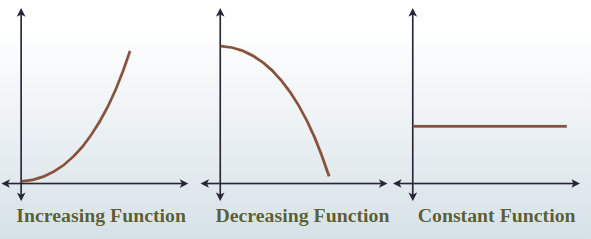Function Behaviors
When we are analyzing functions, we need to have ways to describe the behaviors of said functions. Some common things we use to describe the behavior of functions include the average rate of change, whether it is increasing, decreasing, or constant, and the minimums and maximums found in the function.
Rate of Change
The rate of change describes how an output quantity changes relative to the change in the input quantity. Most time espically with real world data, the rate of change is not constant so we use the average rate of change over a specified period of time. The formula for average rate of change is...
The symbol means the change in a quantity. For example, means the change in .
An example of average rate of change is...
Find the average rate of change of on the interval .
Let and
The average rate of change is .
We can use any point to find the slope of a linear line however when we are finding the average rate of change we need to use the points at the endpoints of the interval because we cannot assume that the rate of change is constant.
Increasing, Decreasing, or Constant
An useful method to describing the behavior of a function is to state if a function is increasing, decreasing, or constant over a given interval.
- An increasing function is a function on an open interval if for any two input values and in a given interval where .
- A decreasing function is a function on an open interval if for any two input values and in the given interval where .
- A constant function is a function on an open interval if for any two input values and .

For the most common functions...
| Name | Function | Increasing \ Decreasing |
|---|---|---|
| Constant | Always constant | |
| Identity | Increasing | |
| Quadratic | Increasing on and Decreasing on | |
| Cubic | Increasing | |
| Reciprocal | Decreasing | |
| Reciprocal Squared | Increasing on and Decreasing on | |
| Cube Root | Increasing | |
| Square Root | Increasing on | |
| Absolute Value | Increasing on and Decreasing on |
Minimum and Maximum
We use the minimum and maximums of a function to help describe all the peaks and valleys that a function may have and also help us understand where the function changes from increasing to decreasing or decreasing to increasing.
The output of the input where a function changes from decreasing to increasing is called the local minimum. In other words, the function has a local minimum at if there exists an interval with such that, for any in the interval , .
The output of the input where a function changes from increasing to decreasing is called the local maximum. In other words, the function has a local maximum at if there exists an interval with such that, for any in the interval , .
If a function has more than one local minimum, we say it has local minima. On the other hand, if the function has more than one local maximum, we use the plural form local maxima to express all of them. Together, the local maxima and minima are called the local extrema or local extreme values.
Also note that sometimes we can encounter the word local replaced with relative which means the same thing.
The absolute minimum of at is for all in the domain of .
The absolute maximum of at is for all in the domain of .
